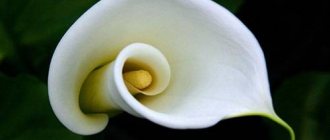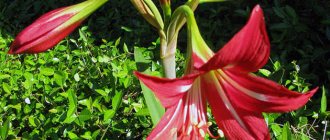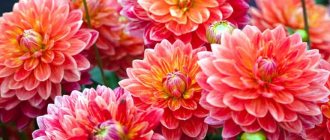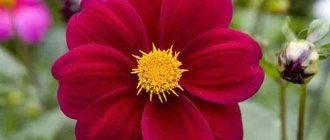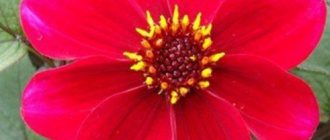Dahlias are flowers that are unpretentious in summer, but in late autumn they require increased attention from the gardener. A large amount of work is due to the fact that dahlia, being a heat-loving crop, cannot remain in the open ground in winter. On the eve of frost, the plant is dug up and stored until spring in the basement or apartment - whichever is more convenient. Proper care of dahlias in the fall and preparation for winter of one of the most beloved crops by flower growers is a guarantee that next year the plant will surprise with its rare decorativeness.
- 2 Cleaning the area
- 3 Preventative examination
- 4 Hilling and pruning
- 5 Watering and fertilizing
- 6 How to dig up dahlias
6.1 Video: preparing dahlias for winter
- 6.2 Video: how to preserve dahlias in winter
- 9.1 Reviews
What care does the plant need in the fall?
In the fall, efforts to care for dahlias are aimed at ensuring that the tubers successfully overwinter
In autumn, care is required for the soil on which dahlias grow (fallen leaves and debris must be removed - possible breeding grounds for infections), and the flower itself. It needs to be prepared for the coming cold weather - hill up, prune, change the order of watering and fertilizing, properly dig up the tubers.
Preparation for the winter period involves a number of activities, each of which requires some effort from the gardener, but allows you to save valuable planting material until spring.
How to store dahlias in sawdust. How to store dahlias after digging - the nuances of the storage mode
It is very difficult to create ideal conditions for storing dahlias, but it is possible to get closer to them. It is especially useful for beginning gardeners to become familiar with the preferences of capricious beauties. Otherwise, there is a risk of destroying the tubers due to improper storage. So, you dug up the dahlias. Storing tubers in winter is best done under the following conditions:
- air temperature – at +5°С;
- optimal humidity - 60−75%;
- good ventilation of the room;
- air must circulate.
Proper storage is the key to success in the coming season
If you ensure the last two points listed, then the risk of fungal infections is minimized. It wouldn’t hurt to pre-disinfect the room or fumigate it with sulfur. The roots are laid in no more than 2 rows. The surface must be dry. The following are used as a substrate:
- dry sand (in rare cases - earth);
- sawdust or large wood shavings;
- any wooden surface.
New technique: wrapping tubers in cling film
Recently, it has been practiced to wrap tubers in cling film before sending them to storage, but this technique has a sufficient number of opponents who are inclined to argue that in such conditions fungal diseases multiply, the plants breathe poorly, and they do not have much chance of surviving until spring . Personally, I had a positive experience of storing dahlias in cling film (there was no other option), however, I will not say that this is one hundred percent effective.
Cleaning the area
Cleaning the soil will help eliminate the possibility of transferring various kinds of diseases to healthy plants.
Not everyone attaches great importance to this work, but in vain: the ground near the bushes must be thoroughly cleared of fallen leaves, petals, branches, and any other debris, since it is in them that various pests survive the longest, as well as pathogens of dangerous fungal infections that can destroy both planting material and plants planted in flower beds.
Cleaning is carried out 2 weeks before digging up dahlias, keeping in mind that when the air and soil temperatures drop, the tubers become especially susceptible to infections. Autumn rains mean that pests that have settled in plant debris can easily get deep into the soil.
The best varieties of dahlias
Cafe au lait. Few plants can match the flawless beauty of this gorgeous plate-sized flower, in which shades of cream, beige and pink delicately flow into each other. This variety is especially popular for summer wedding decorations, so it is a must grow.
Crichton Honey. The large spherical flowers of this unusually productive variety, shining with apricot and peach shades, are one of the most beloved on my plantation.
Punkin Spice. With lush flowers with petals in warm orange, gold and crimson hues, this award-winning variety will make any bouquet unforgettable. Many of the flowers look as if they were painted by hand: not two of them are alike. The stems are quite thin, so take care of additional support for them, otherwise heavy rains will destroy them.
Advertising
Snoho Doris. A stunning variety with bright spherical flowers in warm peachy pink and soft orange hues with strong stems, great for cutting and stands well in bouquets.
Amber Queen. This charming novelty with warm orange pompom flowers will be a wonderful addition to any bouquet. This compact plant with miniature heads also looks great in flower beds, so the love for it will last for a long time.
Appleblossom. Anyone involved in flower arrangements cannot do without this beauty with its delicate and large, tea-saucer-sized flowers in creamy and pink shades. In addition to the fact that it holds up well in a vase, it is incomparable in flower beds.
"Punky Spice", "Amber Queen", "Crichton Honey"
Preventive examination
Sampling of affected plants should be carried out with special care.
All plants have to go through it. If a gardener finds dahlias affected by one disease or another, dried on the root, he will have to dig them up with a clod of earth and burn them in order to stop the spread of infection to neighboring crops. Characteristic signs of infection are a white coating caused by a fungus, brown spots, rot, as well as suspiciously rapid drying of the stem and leaves of the dahlia.
Non-viable plants that have never produced buds throughout the summer and whose stems are too long and fragile are also subject to culling. Unfortunately, we cannot expect that the result will be different next season.
Can dahlias be stored in the refrigerator? How to store dahlias in winter
I store tubers in the basement, as it is more optimal and simpler, but I know several storage methods. The main reason why it is not advisable to store dahlias at home (in the room) is that the tubers dry out. And in the refrigerator - rotting, since in the refrigerator it’s still a plus, it’s cold and often damp. If you plan to store it in a room, then dig up the dahlia after a strong frost, when the green mass has actually frozen and become glassy, the soil is not shaken off from the roots, that is, on the contrary, the largest possible lump is preserved, and placed directly with the lump on the newspaper to dry the top layer land. Next, take, for example, a box into which either sawdust or moss is poured, or you can crumble polystyrene foam and put the entire lump of soil into this filler. In spring, the lump is shaken off and the dahlia is divided. If you plan to store it in the refrigerator, waxing may be the safest option. To do this, we dig up the dahlia after a hard frost, when the greenery turns glassy, wash off all the soil, and dry the tubers. If the tuber is very large, then we divide it into several parts. It is better to divide finely in the spring to be sure that there will be buds on the division. Paraffin is bought at the pharmacy, melted in a saucepan and heated to a temperature of 70-80 degrees. The divisions are dipped into this paraffin. Then they put the waxed tubers, for example, in a cardboard shoe box. and they put it in the refrigerator, you can also use the vegetable drawer from the refrigerator itself.
If there is a glazed balcony, then the waxed tubers can be stored there, but first insulate it very well! For example, with polystyrene foam, wrapped in a very multi-layer covering, or in anything else you can think of. In the spring, there is no need to remove the paraffin; just take the dahlias into a warm place and the sprouts will hatch through the paraffin. I can tell you about my experience of storage in the basement. I have a special basin. I pour new sawdust into it every year. They can be taken from any sawmill. I keep the sawdust for some time in a warm room, right in the basin, and stir it to dry. And sometimes you come across dry ones right away. I dig up dahlias after freezing, wash them from the soil, divide them if they are large roots, and put them in a basin. The main thing is not to touch each other. And without covering the basin with anything, I take it to the basement. In winter I used to check for rot, but in recent years I have stopped doing this, since they feel completely normal in sawdust - they are not wet and do not dry out. Also in the same basin with sawdust, next to the dahlias, I put all the tubers and bulbs that I dig up for the winter - gladioli, callas. Everything overwinters perfectly every year. At one time they tried to store it in a basin and in sand, but it rotted. Apparently the dampness of the basement was absorbed. It would be very great if, as expected, before putting them in the basement, soak the tubers in Maxim for 30 minutes and then dry them after soaking. That is, wash it off the soil and immediately soak it in Maxima. if there are invisible pests on the tubers and bulbs, they will die and the chances of overwintering will increase many times over. Sometimes I soak it myself, sometimes I don’t. I don’t soak it if I see that the tuber is just perfect. If you cut a tuber when digging, then cover the cut with either ash or brilliant green, even iodine will do, or with garden varnish, if you have it at hand (which is used to cover tree cuts). One more nuance. Some varieties of dahlias have a thin tuber, this is a feature of the variety. These are the ones that are most susceptible to drying out. And even in the basement, where it is optimal for them, they can dry out. It is best to bathe such dahlias in paraffin, so as not to be upset in the spring.
Hilling and pruning
Some gardeners believe that if you cut all the stems with one cutting tool, you can spread viral infections to a significant part of the collection
Autumn hilling will protect the root system of the flower from possible night frosts. You can hill up the bush in the first week of September or at the end of August. The height of the mound at the base of the stem should be from 8 to 12 cm.
Trimming the stem at a height of about 15 cm from the ground is carried out after flowering has completed, and each “stump” must be equipped with a tag with the name of the dahlia variety.
Features of culture
Most flower growers dote on dahlias. And this is not surprising, because the flowers under discussion are completely unpretentious and, at the same time, each time they bloom more and more beautifully, filling the flowerbed with bright shades and forcing passers-by to look over the fence in surprise to enjoy this beautiful picture.
Those who have planted flowers for the first time in their practice will certainly sooner or later wonder: is it really necessary to dig up dahlias for the winter, or can this procedure be safely done without. A firm and decisive “no.” If you neglect the rules and leave the root tubers of flowers to winter directly in the open ground, then at least you will not get flowers for the next year. And at the very least, completely destroy the flower bulbs. These plants are not able to survive our severe frosts, so their root tubers must be taken for wintering in the house, basement, balcony - or any other place suitable for the temperature.
It is important not to remove the root tubers from the ground too early. The bulbs must ripen. Otherwise, the period of their storage outside the soil will be significantly reduced, they will be more susceptible to diseases and pests and, most likely, will germinate even before you send them into the soil in the next summer season.
Watering and fertilizing
After each watering or fertilizing, the soil under the dahlias must be loosened and weeds removed.
When it comes to watering, the gardener has to act against nature. The plant, preparing for winter, strives to stock up on moisture, accumulating it in the internodes located in close proximity to the roots. Thanks to this, the tubers will not dry out and active growth will be possible in the spring. However, if there is too much water, it will cause waterlogging of the root collar and rotting of the tubers. To prevent this from happening, watering is stopped two or at least one week before digging up the plants.
If it rains more often, the flowerbed with dahlias is covered with a moisture-proof film so that as little water as possible gets to both the plant itself and the soil.
As for fertilizing, restrictions are introduced here too. When preparing plants for dormancy, the last time fertilizers (potassium and phosphorus) are applied no later than August 20. Dilute 1 tsp into 10 liters of water. potassium sulfate and superphosphate and spend an average of 2–3 liters of solution on each bush.
Dahlia root. Dahlia (Dahlia)
Syn: dalia.
Dahlia is a genus of beautifully flowering annual or perennial plants. Representatives of this genus are used as ornamental plants; they are used to decorate gardens, vegetable gardens, and front gardens. In Mexico, some parts of the dahlia are used for food, the petals are added to salads, and various drinks are prepared based on the tubers. Officially, the plant is not used for medicinal purposes, but in folk medicine it is used as an anti-inflammatory, antifungal and immunostimulating agent.
In medicine
Dahlia is not included in the State Pharmacopoeia of the Russian Federation and is not used in official medicine in Russia. However, Mexican healers have found use for this plant and use it as an anti-inflammatory, antifungal and immunostimulating agent.
Contraindications and side effects
Since representatives of this genus are not used in official medicine, it is difficult to judge the presence of contraindications and side effects. Any use of dahlia for medicinal purposes is contraindicated!
In gardening
To successfully grow these unpretentious ornamental plants, it is very important to choose a good planting site. First of all, you need to avoid drafts and excess direct sunlight. Experienced gardeners recommend planting dahlias near trees so that the plants are periodically in the shade.
It is recommended to water once a week; during heavy rains, watering is not required. Weeding and irrigation of the land is carried out at least once every two weeks. For abundant flowering, the plant is fed with organic fertilizers.
At the first frost, the above-ground part of the plant is cut off, the tubers are dug out of the ground, dried for 24 hours in a warm room, then stored in a cardboard box with sand at an air temperature of 18-20 degrees.
Today there are about 15,000 different species and their forms. In most cases, hybrid dahlia varieties are cultivated. In biology, it is customary to divide dahlias into several groups:
· Collar. The petals are arranged in two rows, each row has its own color. The maximum can reach 50 cm in height. Varieties: Danko's heart, Malivista and others.
· Peony-shaped. Externally similar to peonies. They have two rows of petals. The center is golden. Varieties: Eternal Flame, Danko and others.
· Pompons. Outwardly they resemble a slightly flattened ball. They are classified as medium-sized, up to 1.5 meters in height. Varieties: Baby, Crombie and others.
· Globular. The name speaks for itself, the inflorescences are double and resemble a ball. The plant can reach one and a half meters in length. Varieties: Cambry, Evelyn and others.
· Semi-cactus. The petals located closer to the middle are twisted into a tube. Varieties: Cherry, Vicky, Meteori and others.
· Cactus. A distinctive feature is the structure of the petal. They are twisted into a narrow tube and resemble a cactus. Tall, capable of reaching up to 2 meters in height. Varieties: Candy, Black Wizard and others.
· Nymphaeal. They have large double inflorescences, up to 20 centimeters in diameter. Varieties: Leo, Kens, Nabat and others.
· Mixed. This includes all other varieties that do not belong to the previous groups.
In cooking
In Mexico, dahlia is also used in cooking; its petals are mainly used and added to salads and a variety of dishes. They add a certain piquancy to food. Tubers are also used for food, drinks are made from them and consumed instead of the usual tea or coffee. To improve the taste, milk or cream is added to the drink. The edible parts of the dahlia have a low calorie content; the plant can be an excellent solution for organizing dietary nutrition. Note that in Russia dahlias are exclusively ornamental plants and are not used for food.
In other areas
Low-growing varieties of dahlias are suitable for creating ridges, borders, and arrays. Some species are used in free compositions and group plantings; in single plantings, abundantly flowering or large-flowered varieties are effective. Varieties with long and strong inflorescences are used for cutting.
Tuber division
The main goal of separation is to obtain root tubers of optimal size, when the number of growth points, and, accordingly, shoots on them, will allow for the most luxuriant flowering and proper development of plants
Experienced gardeners divide the tubers soon after digging - leaving this work until spring does not make sense, since the tubers will become coarse and the procedure will become more complicated. During the division process, the planting material is marked so that in the spring the most interesting flower arrangements can be created on the site.
Recent Entries
Lilac perennials that are beautiful, compact and do not crowd out other plants Why when buying seedlings you should not take the sellers’ word for it and how to determine the age of the plant using 3 signs Tomato seedlings have turned purple or whitish: why the color has changed and how to save the plants
If the tubers are small, it is not recommended to divide them into parts.
Timing for digging up dahlia tubers
Most varieties of the flowers under discussion complete their flowering period by mid-September. Some even stop blooming much earlier - around the second half of August. As soon as the dahlias lose their beautiful inflorescences, you can safely think about digging up the tubers. Remember:
- the optimal period for removing tubers from open ground begins in the second half of September and ends on the 15th of October;
- You need to dig up flower tubers until noticeable pre-winter frosts fall on the ground.
If light frosts have already occurred at your dacha, barely “grabbing” the foliage on trees and shrubs, start digging up dahlia bulbs. Otherwise, you risk missing the right moment to implement this process.
Paraffin treatment
Immerse the tuber in melted paraffin for 1 second, remove it, wait a few seconds and lower it back into the resulting liquid.
This procedure well protects planting material from damage during winter. Dried tubers are dipped in molten paraffin. Then drying follows again for at least 2 days. In such a reliable shell, the rhizomes are placed in cardboard boxes. And they can even be stored in the room. When the sprouts begin to hatch in the spring, they will easily overcome the paraffin layer.
You can also use the chicken egg white treatment method. It is whipped, and then the rhizome is coated with it with a brush. To achieve a better result, the treatment is carried out 3-4 times, ensuring that each layer dries completely.
How to prepare tubers for storage
Drying
How to prepare tubers for storage
The peeled tubers are dried in a warm room for a week . During this time, the skin will thicken and become rough. To dry the tubers evenly, you need to turn them over .
Treatment against pests and diseases
After drying, the tubers are carefully examined. Rotten and damaged parts are cut out to healthy tissue. For disinfection, use a pink solution of potassium permanganate or fungicides - Fundazol, Maxim. Thrips, the main enemy, will be destroyed in winter by the insecticides Actellik and Commander.
The tubers are placed in solutions for 30 minutes and then left indoors at +20°C to dry for 2 weeks. Then the prepared tubers are transferred to a winter storage location.
Autumn care for dahlias, taking into account regional characteristics
In an apartment, planting material should be stored in the coldest place; as a rule, they are placed in a box and placed next to the balcony
In the southern regions of Russia, there is a practice of leaving dahlias to overwinter in the ground. Acceptable low temperatures range from -5 to -7°C. Plantings are prepared for wintering as follows: the stems and leaves of dahlias are cut and removed from the flower garden, and the soil is covered with mulch from the bark or branches of coniferous trees. The protective layer should be 5–10 cm. Neither peat nor compost can be used as mulch: if air temperatures are positive, rotting of the cervical part of the roots may begin under a layer of these materials.
However, no matter how carefully the pre-winter preparation of plantings is carried out, there is still a risk of losing flowers. Therefore, many gardeners, even in the south of the country, fearing unpleasant weather surprises, dig up dahlia tubers. This happens at the end of October - beginning of November.
In the Urals, this work usually occurs at the end of September - the first days of October, in Siberia - it is limited to September. In the middle zone (including the Moscow region), dahlia tubers are usually dug up in early October.
When to dig up dahlias in the fall
In many regions, winters are too harsh to leave dahlia tubers in the ground year-round.
After the plants have flowered, they need to be dug up and stored. When the first autumn frosts have passed, remove the tubers from the ground by lifting them with a fork - very carefully so as not to damage the bunches. Then rinse them off, removing any excess soil (I use a high-pressure hose). Dip the tubers in a 5% water solution of bleach and leave them to dry for a day or two somewhere cool - in the garage or basement.
I advise you to divide dahlia tubers annually: they grow quickly and soon become too large. This makes them rot and makes them more difficult to prepare for storage. Once the bunches of tubers are dry after washing, divide them in half with sharp scissors - and they will be easier to work with. Then divide the resulting small bunches into individual tubers.
In order for them to remain viable, it is very important that the eye or eyes (swollen buds) are connected to a whole, healthy tuber. And it is better to immediately throw away those accidentally damaged during processing. When I started growing dahlias, I tried to preserve such tubers, but they certainly began to rot. It is better to get rid of them without regrets.
Over time, you will easily learn to find the eyes and separate the tubers quickly and accurately. Then store them in a newspaper-lined box with slightly damp peat moss or sawdust, or wrap each one in clear cling film. Store them all winter in a cool, dry place between 4 and 10°C, such as a garage or basement. Don't forget to inspect them monthly and throw away tubers that show signs of rot.
Miracle flowers and their characteristics
Biologists classify dahlias as members of the Astrov family. Their genus includes 42 species of perennial plants that have very large flowers. They often look like balls. Dahlias are surrounded by numerous legends. Mexico became the birthplace of this now very popular flower. It has been mentioned since ancient times. The Mayan peoples widely used dahlias to decorate their homes, as well as during various ritual ceremonies. The Aztecs made water pipes from hollow stems, and used the tubers for food.
The flower came to European countries in 1557. Since that time, it has gained its popularity due to its extraordinary beauty. Its healing properties were discovered here. The fructose-containing roots have been widely used to treat diabetes. The petals saved from various skin diseases and bites of all kinds of insects. Years of fruitful work by breeders have given amateur flower growers more than twenty thousand new varieties. Among them there are both perennial and annual plants. The most varied shades, sizes, and shapes of this miracle flower still captivate hearts and do not leave many gardeners indifferent.
Dahlias were named in honor of the outstanding biologist, professor, traveler, who in Russia was called Ivan Ivanovich Georgi.
in sand
Preserving dahlia roots in sand is similar to storing them in sawdust. Before planting the rhizomes, the sand must be calcined to avoid infection of the roots. The layout should be the same as in sawdust, i.e., the roots do not touch each other, in order to avoid infection with rot. We maintain it at a temperature of plus seven degrees and a humidity of 60 percent.
in the cellar
The cellar is an ideal place to store dahlia roots, since the temperature there corresponds to the conditions under which the roots will not germinate. Prepared rhizomes are placed in boxes or on shelves if space allows. You can sprinkle it with pine sawdust. It is better to lay out no more than two rows in boxes. In cellar conditions, constant inspection of the roots is necessary, as they can be damaged by rodents. We immediately discard such roots. We also observe whether our rhizomes have rotted.

